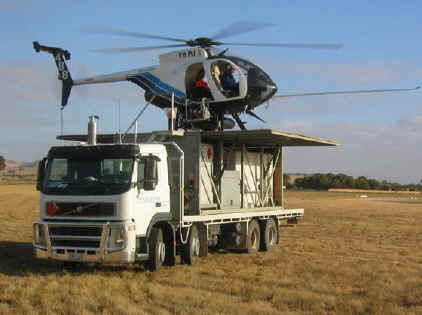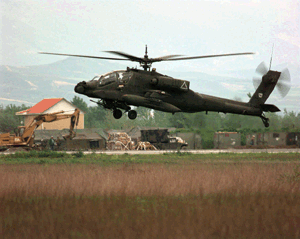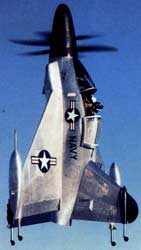Readers must familiarize themselves with these subtopics to understand the concepts discussed in this chapter. These are linked within this chapter, but it may be easier to read them in advance.
Scout Helicopters - much better than UAVs
Pegasus Air Cavalry - swarms of tiny helos are deadly
Role of Attack Helicopters - they are not strike aircraft
RAH-60 Gunhawks - use the AC-130 concept to fire from high above
Update Helicopter Tactics - no more charging into hot LZs
___________________________________________________________
Helicopter operations are part of almost all types of warfare, so this subject is difficult to address in one chapter. Although helicopters may look unchanged from past decades, there have been major advances in engine power. For example, the UH-60L Blackhawk can lift twice as much as the original UH-60A built two decades prior. One new area is using trucks as mobile helicopter bases. The Australian power company, Aeropower, now has portable helicopter landing and service units constructed from a standard 20 ft shipping container fitted with a 4000 liter fuel tank and a 7000 liter water storage, all topped by a fold out landing pad.
 The Volvo truck not only provides vital
refueling and replenishment in isolated
areas, but also delivers a safer and better landing facility for their Hughes
MD500 helicopters. The elevated landing platform is
three meters off the ground and keeps the helicopter clear of dust, which can be
extremely damaging to jet engines. The platform also ensures the aircraft is
clear of people on the ground improving the safety of operations. Such
trucks are ideal for fast-moving armored units so reconnaissance helicopters can
move with them rather than relying on distant bases for support.
The Volvo truck not only provides vital
refueling and replenishment in isolated
areas, but also delivers a safer and better landing facility for their Hughes
MD500 helicopters. The elevated landing platform is
three meters off the ground and keeps the helicopter clear of dust, which can be
extremely damaging to jet engines. The platform also ensures the aircraft is
clear of people on the ground improving the safety of operations. Such
trucks are ideal for fast-moving armored units so reconnaissance helicopters can
move with them rather than relying on distant bases for support.
Tiny Scout Helicopters
Helicopter operations are dependent on air superiority. If a nation cannot rule the skies, investments in helicopters must be limited to tiny scout helicopters, with the exception of medium-lift helicopters needed for peacetime internal security, VIP transport, and medical evacuations. Tiny two-seat helicopters can be armed, easily hidden, and mass for an attack. They may be armed with air-to-air missiles to gun down transport helicopters and aircraft, or engage in an odd form of dogfighting with expensive jet fighter aircraft. With their tiny radar and heat signature and their nimble quickness, it would an interesting fight. Their activities would be difficult to track with airborne radar, which typically ignores or cannot track small objects traveling less than 80 knots, primary because of the clutter of moving ground vehicles. As a result, a tiny scout helo cruising a few feet above a highway at 60 knots is ignored by airborne radar.
 Nations which expect to operate
with air superiority may form large units of air
cavalry using tiny helicopters for massive swarm attacks, like those
now produced in China by Shanghaisikorsky. (left) This is a partnership
with America's famous Sikorsky Helicopter, which is also selling China its latest
medium-lift helicopter, the S-76. Unless an armored force has a very robust air
defense force, tiny armed helicopters massed for attack can easily destroy them
on an open battlefield. Robust means one air defense platform for every
three combat vehicles. This should be standard for mobile ground
forces that do not expect air superiority. Tiny scout helicopters
can also deploy atop trucks and provide excellent frontline support to battalion-size units.
Nations which expect to operate
with air superiority may form large units of air
cavalry using tiny helicopters for massive swarm attacks, like those
now produced in China by Shanghaisikorsky. (left) This is a partnership
with America's famous Sikorsky Helicopter, which is also selling China its latest
medium-lift helicopter, the S-76. Unless an armored force has a very robust air
defense force, tiny armed helicopters massed for attack can easily destroy them
on an open battlefield. Robust means one air defense platform for every
three combat vehicles. This should be standard for mobile ground
forces that do not expect air superiority. Tiny scout helicopters
can also deploy atop trucks and provide excellent frontline support to battalion-size units.
Some wooden fishing boats have a tiny helicopter for spotting schools of fish, yet some billion-dollar navy destroyers have nothing. The easiest and fastest way for any navy to enhance its capabilities is to buy tiny two-seat helicopters. Navies often use $40 million anti-submarine helicopters with three crewmen for basic "milk run" missions, like moving personnel and spare parts between ships and shore installations. Using expensive helicopters that cost $4000 an hour to operate is a waste of resources and detracts from core missions. US Navy ships are so dependent on their helicopters that a Fleet Admiral reviews a daily report about their status.
Tiny two-seat helicopters will prove superior for many naval combat missions since they have a tiny radar, heat, and noise signature. Sea rescue is easy since their low rotor downwash allows them to pluck people directly out the water. Modern navies should put at least one of these helicopters on all of its ships, including small patrol ships, for simple intercept missions. They can launch a tiny helicopter whose passenger points an automatic weapon at the boat so they get the message to stop. Otherwise, he can begin shooting at the engine and controls, then they will get the message. They may shoot back, then the ship can sink that hostile craft.
Large Helicopters
Large attack helicopters are valuable on the modern battlefield if properly employed, as explained in this article: Role of Attack Helicopters. The United States lost thousands of helicopters during the Vietnam war. Those were very basic, inexpensive designs.Today's helicopters are much more capable, yet far more expensive. In addition, anti-aircraft weaponry has improved and the RPG has become ubiquitous and a proven helicopter killer. Aircraft combat losses are not normally made public, but Aviation Week reported that in the year 2003, the US Army lost 41 helicopters over Iraq and Afghanistan from enemy fire in rather light counterinsurgency operations, with another 24 so badly damaged they were scrapped.
 This is one reason the Army canceled the RAH-66 Comanche helicopter in 2005,
which would have cost $60 million per copy. Helicopter
designs must be simple to keep the unit price low and they must be employed
conservatively as they are not easily replaced.
Attack and reconnaissance helicopters have found it difficult to support
infantrymen in urban and forested terrain since they cannot see targets well. For such environments, armies need helicopters that can shoot
downward as well as forward. In low threat environments, helicopters like RAH-60 Gunhawks
that can hover 5000 feet above an enemy and rain firepower directly
downward are valuable.
This is one reason the Army canceled the RAH-66 Comanche helicopter in 2005,
which would have cost $60 million per copy. Helicopter
designs must be simple to keep the unit price low and they must be employed
conservatively as they are not easily replaced.
Attack and reconnaissance helicopters have found it difficult to support
infantrymen in urban and forested terrain since they cannot see targets well. For such environments, armies need helicopters that can shoot
downward as well as forward. In low threat environments, helicopters like RAH-60 Gunhawks
that can hover 5000 feet above an enemy and rain firepower directly
downward are valuable.
Medium-lift transport helicopters have become sophisticated and expensive as well, around $20 million each; the V-22 is around $70 million each. Since they are limited in numbers, they must be employed conservatively, no more charging into hot landing zones as was often done during the Vietnam war. This article Update Helicopter Tactics provided details. When the idea of using helicopters to insert soldiers near enemy forces was first proposed, there was much concern about their vulnerability. As a result, the standard tactic in 1965 was for the helicopter to slow to five knots as soldiers leap out of side doors. See the movie "We Were Soldiers Once" for footage of this.
Operation Lam Son 719 began in early 1971 and was the last major employment of helicopters by the US military. It was launched into Laos to sever the Ho Chi Minh Trail supply line. The United States provided logistical, aerial, and artillery support to the operation. American ground forces were prohibited by Congress from entering Laotian territory, but supported the offensive by rebuilding the airfield at Khe Sanh. South Vietnam provided its best units for this month long offensive and the Pentagon was confident that American firepower and aerial mobility would guarantee victory. After a series of bloody battles, the South Vietnamese retreated back home after losing nearly 1600 men. The U.S. Army lost 215 men killed, 1149 wounded, 38 missing, and lost 108 helicopters while 7 American fighter-bombers were shot down. All of these aircraft were downed with basic AAA weapons as the North Vietnamese had no SAMs in Laos, nor any radar-guided AAA guns, suicide micro drones, or video guided missiles.
 Helicopters are like amphetamines, they make you feel great but are harmful to
your health. The late Col. Fletcher Prouty USAF wrote that the heavy use of
helicopters was a problem in Vietnam. He noted they required one-third the
manpower and logistics and resulted in roughly one third of American casualties.
This estimate seems high, but helicopters required huge base camps to protect
them from the range of enemy heavy machine guns and mortars. Nevertheless,
hundreds of helicopters were destroyed on the ground in Vietnam.
Helicopters are like amphetamines, they make you feel great but are harmful to
your health. The late Col. Fletcher Prouty USAF wrote that the heavy use of
helicopters was a problem in Vietnam. He noted they required one-third the
manpower and logistics and resulted in roughly one third of American casualties.
This estimate seems high, but helicopters required huge base camps to protect
them from the range of enemy heavy machine guns and mortars. Nevertheless,
hundreds of helicopters were destroyed on the ground in Vietnam.
Huge numbers of troops were required to run these camps and protect them. Big daily convoys were needed to provide the fuel and support the big camps, and those needed infantry protection. Helicopters were shot down daily while crashes due to mechanical problems were common. These required helicopters and crews on standby for rescue and recover efforts. Pilot and repair personnel were always short due to their extensive and lengthy training periods. Finally, helicopters were required for convoy and base camp protection needed to support helicopter operations! Col. David Hackworth wrote that his most successful operations occurred when he surprised the enemy by marching his troops long distances to areas where the enemy expected the noise of helicopters to alert them.
During the 1991 Gulf War and 2003 invasion of Iraq, proposals for major airborne and helicopter assault operations into hostile territory were considered, but Generals wisely deemed them nutty. In 1991, the Marines launched "Task Force X-Ray" to land an infantry battalion with 51 helicopters into a blocking position in Kuwait. Despite total air superiority, nearby modern airfields, and weeks of planning, it was aborted after the helicopters were airborne. It became evident the operation was too complex and too dangerous even against a demoralized enemy that was still capable of downing vulnerable helicopters. In 2003, Army Generals okayed dropping 954 paratroopers in northern Iraq where American Special Operations soldiers and their Kurdish troops had already secured the drop zone. It took 15 hours to assembled the scattered soldiers in this unnecessary side show where aircraft could have simply landed at the airfield.
Some officers pushed this concept too far, employing larger helicopters with dozens of troops filing out a back ramp while under hostile fire. A helicopter often sat on the ground for up to three minutes waiting for the tightly packed soldiers to disembark, and this led to many disasters in Vietnam. This danger has worsened as Rocket Propelled Grenades have become common. In addition, larger helicopters are bigger targets and less able to make sharp maneuvers in landing zones. The US Army lost dozens of soldiers when large helicopters were downed in Iraq and Afghanistan. A May 2002 Washington Post story from Afghanistan tells of what happens when a large helicopter lands near enemy forces and everyone must file out the back ramp:
"The Rangers were supposed to exit down a back ramp in an order they had practiced countless times. Those on the left would assemble outside on the left side of the chopper. Those on the right would assemble right. But the moment had turned into a mad scramble to get out in whatever order they could. One Ranger, Spc. Marc A. Anderson, was shot and killed while still in the helicopter. Two others -- Pfc. Matthew A. Commons and Sgt. Bradley S. Crose -- were gunned down on the ramp."
There are situations where soldiers must be airlifted near enemy forces. In those cases, a helicopter must have side doors for immediate exit, not only to leap out in a landing zone, but to leap out should the helicopter crash land. Smaller is better, like the AH-6 used by US Army Rangers. This is the common civilian MD-500 that is very nimble and simple to maintain. Helicopters no larger than the US Army Blackhawk, depicted in the great movie "Blackhawk Down," should be sent near enemy forces. Larger helicopters are too expensive, too valuable, less maneuverable, and too lethal for troops trapped inside a cabin should something go wrong while under enemy fire. In summary, helicopters with a rear ramp are cargo helicopters and a not assault helicopters, and should not be used to insert troops near enemy forces.
Tilt-rotors and Other Bad Ideas
Many innovative Vertical Take-off and Landing (VTOL) designs have been tested since the helicopter first made its appearance during World War II. The Navy XFY-1 Pogo was a revolutionary "tail sitter" aircraft capable of vertical take-offs and landings. A high performance fighter that could take off and land vertically, like a helicopter! No more need to depend upon elaborate and vulnerable airfield facilities in time of war. Every paved highway, even every level patch of farmland suddenly capable of launching a cloud of fighters to deal with an invading army. Fighter protection at sea that doesn’t require huge aircraft carriers -- every destroyer, even every transport and oiler, capable of carrying one or two fighters of its own!
 The XFY-1 (right) was able to successfully take off and
land vertically. The project was cancelled at the completion of this flight test
program in 1955 from a combination of handling problems and the realization that
the design could not match the performance of contemporary fighter aircraft. The
main problems with these VTOL airplanes were the tricky piloting maneuvering
required in the take-off and landing and the need to tilt the entire aircraft
over into conventional flight. The XFY-1 was an interesting
"revolutionary" idea, like the V-22 tiltrotor has been touted. However,
it was unsafe, so the program was cancelled.
The XFY-1 (right) was able to successfully take off and
land vertically. The project was cancelled at the completion of this flight test
program in 1955 from a combination of handling problems and the realization that
the design could not match the performance of contemporary fighter aircraft. The
main problems with these VTOL airplanes were the tricky piloting maneuvering
required in the take-off and landing and the need to tilt the entire aircraft
over into conventional flight. The XFY-1 was an interesting
"revolutionary" idea, like the V-22 tiltrotor has been touted. However,
it was unsafe, so the program was cancelled.
Unfortunately, the V-22 tilt-rotor is a failed design too. Its rotors are not attached near it's center of gravity like helicopters, they are on its wingtips. Thus, it has a tendency to roll over should anything cause a problem with one rotor, as this article explains: Why the V-22 Osprey is Unsafe It is a compromise between an aircraft and a helicopter, so it is only half as capable as a similar size aircraft like the C-27J, and only one-third as capable as a similar size helicopter like the CH-53E. Finally, since it is inherently unstable, it must descend with slow caution into an landing zone, cannot make abrupt changes to avoid enemy gunfire, and its troops must patiently file out a back ramp while it sits in a landing zone. This is not a safe aircraft, it costs over $70 million each; it is not an "assault" aircraft like it claims.
The V-22 represents everything a future helicopter should not be. Now there is a push for a "quadrotor" V-22, e.g. two V-22s stuck together. This is very bad idea. Helicopters have evolved into valuable machines and there is nothing in development that can replace them at this time. A nation's military should focus on low-cost, reliable, safe designs, whose development and spare parts costs can be offset by commercial and foreign sales. Given the costs, it make no sense to build larger and larger helicopters, which only become easier to shoot down. The US Army must focus efforts on maintaining a successful basic design like the CH-47F in service, and keep these far away from enemy guns and missiles.
©2015 www.G2mil.com